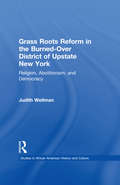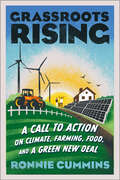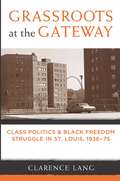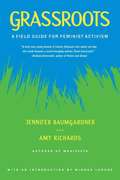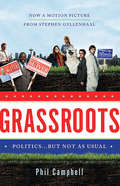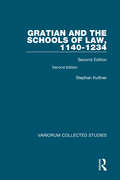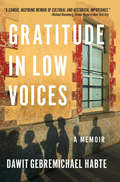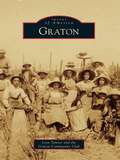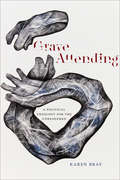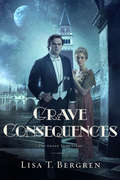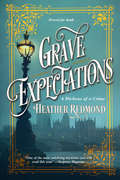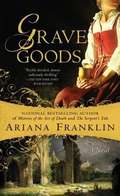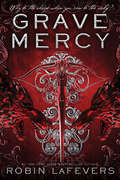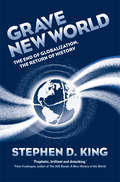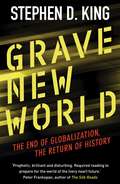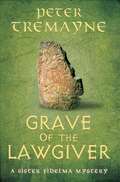- Table View
- List View
Grassroots Reform in the Burned-over District of Upstate New York: Religion, Abolitionism, and Democracy (Studies in African American History and Culture)
by Judith WellmanFirst published in 2001. Routledge is an imprint of Taylor & Francis, an informa company.
Grassroots Resistance: Social Movements in Twentieth Century America
by Robert A. GoldbergThe Anti-Saloon League, the Berkeley Free Speech Movement, the Ku Klux Klan--different times and different ideas, yet joined in a continuity of change within U.S. history. Grassroots Resistance: Social Movements in Twentieth Century America explores the historical contexts, specific dynamics, and conceptual links among eight significant movements of this century.
Grassroots Rising: A Call to Action on Climate, Farming, Food, and a Green New Deal
by Ronnie Cummins&“This is a book that should be in the hands of every activist working on food and farming and climate change.&”—Vandana ShivaA practical, shovel-ready plan for anyone wondering what they can do to help address the global climate crisisGrassroots Rising is a passionate call to action for the global body politic, providing practical solutions for how to survive—and thrive—in catastrophic times. Author Ronnie Cummins, founder and director of the Organic Consumers Association, aims to educate and inspire citizens worldwide to organize and become active participants in preventing ecological collapse.This book offers a blueprint for building and supercharging a grassroots Regeneration Movement based on:• Consumer activism• Farmer innovation• Political change• Regenerative financeCummins asserts that the solution lies right beneath our feet and at the end of our forks through the transformation of our broken food system. Using regenerative agriculture practices that restore our agricultural and grazing lands, we can sequester massive amounts of carbon in the soil. Coupled with an aggressive transition toward renewables, he argues that we have the power to not only mitigate and slow down climate change, but actually reverse global warming by strengthening our infrastructure.Grassroots Rising shows that a properly organized and executed Regeneration Revolution can indeed offer realistic climate solutions while also meeting our everyday needs.&“This is a &‘good news&’ instructional book for Regeneration, a plan of action for the United States and the world to transition to climate stability, peace, justice, health, prosperity, cooperation, and participatory democracy.&”—Ronnie Cummins
Grassroots at the Gateway
by Clarence Lang"This is a theoretically sophisticated and thoroughly documented historical case study of the movements for African American liberation in St. Louis. Through detailed analysis of black working class mobilization from the depression years to the advent of Black Power, award-winning historian Clarence Lang describes how the advances made in earlier decades were undermined by a black middle class agenda that focused on the narrow aims of black capitalists and politicians. The book is a major contribution to our understanding of the black working class insurgency that underpinned the civil rights and Black Power campaigns of the twentieth century. " ---V. P. Franklin, University of California, Riverside "A major work of scholarship that will transform historical understanding of the pivotal role that class politics played in both civil rights and Black Power activism in the United States. Clarence Lang's insightful, engagingly written, and well-researched study will prove indispensable to scholars and students of postwar American history. " ---Peniel Joseph, Brandeis University Breaking new ground in the field of Black Freedom Studies,Grassroots at the Gatewayreveals how urban black working-class communities, cultures, and institutions propelled the major African American social movements in the period between the Great Depression and the end of the Great Society. Using the city of St. Louis in the border state of Missouri as a case study, author Clarence Lang undermines the notion that a unified "black community" engaged in the push for equality, justice, and respect. Instead, black social movements of the working class were distinct from---and at times in conflict with---those of the middle class. This richly researched book delves into African American oral histories, records of activist individuals and organizations, archives of the black advocacy press, and even the records of the St. Louis' economic power brokers whom local black freedom fighters challenged. Grassroots at the Gatewaycharts the development of this race-class divide, offering an uncommon reading of not only the civil rights movement but also the emergence and consolidation of a black working class. Clarence Lang is Assistant Professor in African American Studies and History at the University of Illinois at Urbana-Champaign. Photo courtesy Western Historical Manuscript Collection, University of Missouri, St. Louis
Grassroots for Hire
by Edward T. WalkerAlthough 'grassroots' conjures up images of independent citizen organizing, much mass participation today is sponsored by elite consultants working for corporations and powerful interest groups. This book pulls back the curtain to reveal a lucrative industry of consulting firms that incentivize public activism as a marketable service. Edward Walker illustrates how, spurred by the post-sixties advocacy explosion and rising business political engagement, elite consultants have deployed new technologies to commercialize mass participation. Using evidence from interviews, surveys and public records, Grassroots for Hire paints a detailed portrait of these consultants and their clients. Today, Fortune 500 firms hire them to counter-mobilize against regulation, protest or controversy. Ironically, some advocacy groups now outsource organizing to them. Walker also finds that consultants are reshaping both participation and policymaking, but unethical 'astroturf' strategies are often ineffective. This pathbreaking book calls for a rethinking of interactions between corporations, advocacy groups, and elites in politics.
Grassroots: A Field Guide for Feminist Activism
by Jennifer Baumgardner Amy RichardsFrom the authors of Manifesta, an activism handbook that illustrates how to truly make the personal political. Grassroots is an activism handbook for social justice. Aimed at everyone from students to professionals, stay-at-home moms to artists, Grassroots answers the perennial question: What can I do? Whether you are concerned about the environment, human rights violations in Tibet, campus sexual assault policies, sweatshop labor, gay marriage, or the ongoing repercussions from 9-11, Jennifer Baumgardner and Amy Richards believe that we all have something to offer in the fight against injustice. Based on the authors' own experiences, and the stories of both the large number of activists they work with as well as the countless everyday people they have encountered over the years, Grassroots encourages people to move beyond the "generic three" (check writing, calling congresspeople, and volunteering) and make a difference with clear guidelines and models for activism. The authors draw heavily on individual stories as examples, inspiring readers to recognize the tools right in front of them--be it the office copier or the family living room--in order to make change. Activism is accessible to all, and Grassroots shows how anyone, no matter how much or little time they have to offer, can create a world that more clearly reflects their values.
Grassroots: Politics . . . But Not as Usual
by Phil CampbellThis offbeat true story is a comedy and a tragedy about politics, from anti-globalist protest to domestic turmoil. It's about idealism, obsession and failure in Seattle, a progressive city on the fringe of America's continent and consciousness. Grant Cogswell is a poet, a punk rock-fan, an anarchist, a grassroots activist, and one very temperamental character. He loves Seattle so much he has the city logo tattooed on his arm. In the summer of 2001 he decides to run for city council. He's so determined to win that he'll even wear a polar-bear suit to a city hall meeting. Phil Campbell, the author, is a burnt-out recently fired alt-weekly reporter, a manic depressive who sees few reasons to live. Inspired by his friend Grant's passion, and without anything better to do, he agrees to manage Grant's campaign. For eighteen weeks, Phil devotes himself to Grant's grassroots challenge-all the while fending an overzealous roommate challenging him for his position as manager of their shared house. Overshadowing the story is the tale of U. S. Rep. Marion Anthony Zioncheck, a legendary boozer and forgotten lefty radical from the 1930s. As Grant's campaign unfolds, so does the story of Zioncheck's tragedy - his rise and fall from an energetic young politico to a madman who is sent to the insane asylum. The question: Is Zioncheck's tale a lesson already learned, or a prophecy waiting to be repeated?
Gratian and the Schools of Law, 1140-1234: Second Edition (Variorum Collected Studies)
by Stephan KuttnerCollected Studies CS1071 The central figure in this volume is that of Gratian, whose monumental compilation of canon law sparked off the revival of legal studies in the medieval West. In other collections of essays, Stephan Kuttner dealt with the development of canon law in the two centuries that followed the publication of Gratian's Decretum, and the ideas that this engendered; here he is concerned with the foundations upon which all these later efforts were based. The work of Gratian is, of course, the principal focus, but the studies then follow the spread of the teaching of law, from its inception at Bologna in the 1140s to its appearance soon after in other centres of learning in the West especially in France, in the Anglo-Norman schools and in Germany. With a quarter of the volume consisting of additional notes and extensive indexes, it makes a contribution of the greatest importance to the historical study of canon law. For this second edition, a new section of additional notes has been supplied, and the volume is introduced with an essay by Peter Landau; these take account of the important recent work on Gratian and the Decretum and chart the significance of Stephan Kuttner's work.
Gratitude in Low Voices: A Memoir
by Dawit Gebremichael Habte&“A candid, inspiring memoir of cultural and historical importance&” from an Eritrean-Ethiopian War refugee (Michael Bloomberg).Dawit Gebremichael Habte fled his homeland of Eritrea as a teenager. In the midst of the ongoing Eritrean-Ethiopian war, Dawit and his sisters crossed illegally into Kenya. Without their parents or documents to help their passage, they experienced the abuse and neglect known by so many refugees around the world. But Dawit refused to give up. He stayed resilient and positive. Journeying to the United States under asylum—and still a boy—Dawit found a new purpose in an unfamiliar land. Against impossible odds, he studied hard and was accepted to Johns Hopkins University, eventually landing a job as a software engineer at Bloomberg. After a few years, with the support of Michael Bloomberg himself, Dawit returned to his homeland to offer business opportunities for other Eritreans. Dawit found a way to help his ancestral land emerge from thirty years of debilitating war.Gratitude in Low Voices is about how one man was marginalized, but how compassion and love never abandoned him. It&’s about learning how to care for family, and how to honor those who help the helpless. This account reminds us that hope is not lost. &“An inspiring memoir by Dawit Gebremichael Habte, who poignantly portrays his childhood in Africa and his struggles as a refugee to the United States . . . This book is a reaffirmation of the good that people can do and how one young man succeeded despite the odds against him.&”—Foreword Reviews
Gratitude: Reflections on What We Owe to Our Country
by William F. Buckley Jr.William F. Buckley, Jr., "Mr. Conservative," believes that something must be done to revive our youth's indifference to today's government and politics. In "Gratitude" he offers a plan for universal voluntary national service for men and women 18 years of age and older. Here are his suggestions for how such a program might be structured and administered; on the inducements and sanctions appropriate to its realization; analysis of the benefits, material and spiritual, that would come to those who serve; and an idea of the benefits to those who are served.
Graton
by Lesa Tanner Graton Community ClubThe town of Graton is located in the beautiful and fertile Green Valley, which was first settled in the mid-1800s by pioneer families such as the Sullivans, Gregsons, and Winklers. When the railroad came through the area, realtor James Gray and banker J. H. Brush bought land and created one of the first subdivisions in Sonoma County. They named the streets after themselves and their children, and in 1905, Graton was born. Along with the agricultural industry in California, the town thrived until the 1970s and then declined, only to be reborn in the 1990s. Throughout all Graton's phases, Oak Grove School (1854), the Pacific Christian Academy (1918), and the Graton Community Club (1914) remained vital. Graton is now part of a premiere wine-growing region, and visitors as well as locals are attracted to its vibrant downtown businesses, award-winning restaurants, and artistic community.
Grave Attending: A Political Theology for the Unredeemed
by Karen Bray“This is a book about what it would mean to be a bit moody in the midst of being theological and political. Its framing assumption is that neoliberal economics relies on narratives in which not being in the right mood means a cursed existence.” So begins Grave Attending: A Political Theology for the Unredeemed, which mounts a challenge to neoliberal narratives of redemption. Mapping the contemporary state of political theology, Karen Bray brings it to bear upon secularism, Marxist thought, affect theory, queer temporality, and other critical modes as a way to refuse separating one’s personal mood from the political or philosophical. Introducing the concept of bipolar time, she offers a critique of neoliberal temporality by countering capitalist priorities of efficiency through the experiences of mania and depression. And it is here Bray makes her crucial critical turn, one that values the power of those who are unredeemed in the eyes of liberal democracy—those too slow, too mad, too depressed to be of productive worth—suggesting forms of utopia in the poetics of crip theory and ordinary habit. Through performances of what she calls grave attending—being brought down by the gravity of what is and listening to the ghosts of what might have been—Bray asks readers to choose collective care over individual overcoming.Grave Attending brings critical questions of embodiment, history, and power to the fields of political theology, radical theology, secular theology, and the continental philosophy of religion. Scholars interested in addressing the lack of intersectional engagement within these fields will find this work invaluable. As the forces of neoliberalism demand we be productive, efficient, happy, and flexible in order to be deemed worthy subjects, Grave Attending offers another model for living politically, emotionally, and theologically. Instead of submitting to such a market-driven concept of salvation, this book insists that we remain mad, moody, and unredeemed. Drawing on theories of affect, temporality, disability, queerness, work, and race, Bray persuades us that embodying more just forms of sociality comes not in spite of irredeemable moods, but through them.
Grave Birds: A Novel
by Dana ElmendorfThe Southern Book Club's Guide to Slaying Vampires meets Midnight in the Garden of Good and Evil in this twisty, fresh take on a Southern gothic that follows a mysterious, charming bachelor as he makes his way into a small town, bringing a plague and the devil with him, from GMA Buzz Pick author Dana Elmendorf.Grave birds haunt the cemeteries of Hawthorne, South Carolina, where Spanish moss drips from the trees and Southern charm is imbued with lies. Hollis Sutherland never knew these unique birds existed, not until she died and was brought back to life. The ghostly birds are manifestations of the dead&’s unfinished business, and they know Hollis and her uncanny gift can set them free.When a mysterious, charming bachelor wanders into the small town, bizarre events begin to plague its wealthiest citizens—blood drips from dogwood blossoms, flocks of birds crash into houses, fire tornadoes descend from the sky. Hollis knows these are the omens her grandfather warned about, announcing the devil&’s return. But despite Cain Landry&’s eerie presence and the plague that has followed him, his handsome face and wicked charm win over the townsfolk. Even Hollis falls under his spell as they grow closer.That is, until lies about the town&’s past start to surface. The grave birds begin to show Hollis the dead&’s ugly deeds from some twenty-five years ago and the horrible things some people did to gain their wealth. Hollis can&’t decide if Cain is some immortal hand of God, there to expose their sins. Or if he&’s a devil there to ruin them all. Either way, she&’s determined to save her town and the people in it, whatever it takes.
Grave Consequences
by Lisa T. BergrenThe Powerful, Epic Romance ContinuesFor Cora Kensington, the journey of a lifetime takes unexpected twists. And her future--her very life--depends on the decisions she'll make at each crossroad. As her European tour with her newfound family takes her through Austria, France, and Italy, an unseen enemy trails close behind. Meanwhile, a forbidden love continues to claim her heart, putting everyone's plans in danger. And as Cora stays one step ahead of it all, what might need the most protection is her own heart, torn between the dramatic pursuit of a dashing Frenchman and a man who has been quietly staking claim to her affections all along. Love has dangers all its own. She must escape the bonds of the past and discover the faith to make the right choices, as each one has grave consequences.
Grave Expectations (A Dickens of a Crime #2)
by Heather RedmondOn the eve of Victorian England, Charles Dickens and Kate Hogarth must solve the murder of a spinster wearing a wedding gown . . . London, June 1835: In the interest of being a good neighbor, Charles checks in on Miss Haverstock, the elderly spinster who resides in the flat above his. But as the young journalist and his fiancée Kate ascend the stairs, they are assaulted by the unmistakable smell of death. Upon entering the woman&’s quarters, they find her decomposing corpse adorned in a faded gown that looks like it could have been her wedding dress, had she been married. A murderer has set the stage. But to what purpose? As news of an escaped convict from Coldbath Fields reaches the couple, Charles reasonably expects the prisoner, Ned Blood, may be responsible. But Kate suspects more personal motives, given the time and effort in dressing the victim. When a local blacksmith is found with cut manacles in his shop and arrested, his distraught wife begs Charles and Kate to help. At the inquest, they are surprised to meet Miss Haverstock&’s cold and haughty illegitimate daughter, shadowed by her miserably besotted companion. Secrets shrouded by the old woman&’s past may hold the answers to this web of mystery. But Charles and Kate will have to risk their lives to unveil the truth . . . &“As easy to read as one of Mr. Dickens&’ actual novels and as entertaining.&”—New York Journal of Books &“Once again, Redmond mixes history, mystery, and a little bit of whimsy.&”—Kirkus Reviews &“Captures the young Charles&’s ebullient energy, the warmth of his circle, and the color of a fast-changing era. Readers will look forward to Charles&’s further adventures.&”—Publishers Weekly &“Fans of Anne Perry will love this one.&” —Dianne Freeman, award winning author
Grave Goods (Mistress of the Art of Death #3)
by Ariana FranklinThe "richly detailed, almost indecently thrilling" (New York Times) follow up to The Serpent's Tale When a fire at Glastonbury Abbey reveals two skeletons, rumor has it they may belong to King Arthur and Queen Guinevere. King Henry II hopes so, for it would help him put down a rebellion in Wales, where the legend of Celtic savior Arthur is strong. To make certain, he sends Adelia Aguilar, his Mistress of the Art of Death, to Glastonbury to examine the skeletons. At the same time, the investigation into the abbey fire will be overseen by the Bishop of St. Albans, father of Adelia's daughter. Trouble is, someone at Glastonbury doesn't want either mystery solved, and is prepared to kill to prevent it...
Grave Matters: The Controversy over Excavating California's Buried Indigenous Past
by Tony PlattWhether by curious Boy Scouts and &“backyard archaeologists&” or competitive collectors and knowledge-hungry anthropologists, the excavation of Native remains is a practice fraught with injustice and simmering resentments. Grave Matters is the history of the treatment of Native remains in California and the story of the complicated relationship between researcher and researched. Tony Platt begins his journey with his son’s funeral at Big Lagoon, a seaside village in pastoral Humboldt County in Northern California, once O-pyúweg, a bustling center for the Yurok and the site of a plundered native cemetery. Platt travels the globe in search of the answer to the question: How do we reconcile a place of extraordinary beauty with its horrific past? Grave Matters centers the Yurok people and the eventual movement to repatriate remains and reclaim ancient rights, but it is also a universal story of coming to terms with the painful legacy of a sorrowful past. This book, originally published in 2011, is updated here with a preface by the author.
Grave Mercy (His Fair Assassin #1)
by Robin LaFeversWhy be the sheep, when you can be the wolf?Seventeen-year-old Ismae escapes from the brutality of an arranged marriage into the sanctuary of the convent of St. Mortain, where the sisters still serve the gods of old. Here she learns that the god of Death Himself has blessed her with dangerous gifts—and a violent destiny. If she chooses to stay at the convent, she will be trained as an assassin and serve as a handmaiden to Death. To claim her new life, she must destroy the lives of others. Ismae’s most important assignment takes her straight into the high court of Brittany—where she finds herself woefully under prepared—not only for the deadly games of intrigue and treason, but for the impossible choices she must make. For how can she deliver Death’s vengeance upon a target who, against her will, has stolen her heart?
Grave Mercy: His Fair Assassin, Book I (His Fair Assassin #1)
by Robin LafeversWhy be the sheep, when you can be the wolf? Seventeen-year-old Ismae escapes from the brutality of an arranged marriage into the sanctuary of the convent of St. Mortain, where the sisters still serve the gods of old. Here she learns that the god of Death Himself has blessed her with dangerous gifts--and a violent destiny. If she chooses to stay at the convent, she will be trained as an assassin and serve as a handmaiden to Death. To claim her new life, she must destroy the lives of others. Ismae's most important assignment takes her straight into the high court of Brittany--where she finds herself woefully under prepared--not only for the deadly games of intrigue and treason, but for the impossible choices she must make. For how can she deliver Death's vengeance upon a target who, against her will, has stolen her heart?
Grave New World: The End of Globalization, the Return of History
by Stephen D. KingA controversial look at the end of globalization and what it means for prosperity, peace, and the global economic order Globalization, long considered the best route to economic prosperity, is not inevitable. An approach built on the principles of free trade and, since the 1980s, open capital markets, is beginning to fracture. With disappointing growth rates across the Western world, nations are no longer willing to sacrifice national interests for global growth; nor are their leaders able—or willing—to sell the idea of pursuing a global agenda of prosperity to their citizens. Combining historical analysis with current affairs, economist Stephen D. King provides a provocative and engaging account of why globalization is being rejected, what a world ruled by rival states with conflicting aims might look like, and how the pursuit of nationalist agendas could result in a race to the bottom. King argues that a rejection of globalization and a return to “autarky” will risk economic and political conflict, and he uses lessons from history to gauge how best to avoid the worst possible outcomes.
Grave New World: The End of Globalization, the Return of History
by Stephen D. KingA controversial look at the end of globalization and what it means for prosperity, peace, and the global economic order Globalization, long considered the best route to economic prosperity, is not inevitable. An approach built on the principles of free trade and, since the 1980s, open capital markets, is beginning to fracture. With disappointing growth rates across the Western world, nations are no longer willing to sacrifice national interests for global growth; nor are their leaders able—or willing—to sell the idea of pursuing a global agenda of prosperity to their citizens. Combining historical analysis with current affairs, economist Stephen D. King provides a provocative and engaging account of why globalization is being rejected, what a world ruled by rival states with conflicting aims might look like, and how the pursuit of nationalist agendas could result in a race to the bottom. King argues that a rejection of globalization and a return to “autarky” will risk economic and political conflict, and he uses lessons from history to gauge how best to avoid the worst possible outcomes.
Grave Secrets of Dinosaurs
by Phil ManningMany of us have seen dinosaur bones and skeletons, maybe even dinosaur eggs...but what did those fearsome animals really look like in the flesh? Soft-tissue fossils give tantalizing clues about the appearance and physiology of the ancient animals. In this exciting book, paleontologist Phillip Manning presents the most astonishing dinosaur fossil excavations of the past 100 years--including the recent discovery of a remarkably intact dinosaur mummy in the Badlands of North Dakota.Bone structure is just the beginning of our knowledge today, thanks to amazing digs like these. Drawing on new breakthroughs and cutting-edge techniques of analysis, Dr. Manning takes us on a thrilling, globe-spanning tour of dinosaur mummy finds--from the first such excavation in 1908 to a baby dinosaur unearthed in 1980, from a dino with a heart in South Dakota to titanosaur embryos in Argentina. And he discusses his own groundbreaking analysis of "Dakota," discovered by Tyler Lyson.Using state-of-the-art technology to scan and analyse this remarkable discovery, National Geographic and Dr. Manning create an incredibly lifelike portrait of Dakota. The knowledge to be gained from this exceedingly rare find, and those that came before it, will intrigue dinosaur-loving readers of all ages.
Grave and Learned Men: 500 Reflections on the RCP, 1518-2018: 05 Book Six (500 Reflections on the RCP, 1518-2018 #6)
by Louella VaughanThe Royal College of Physicians celebrates its 500th anniversary in 2018, and to observe this landmark is publishing this series of ten books. Each of the books focuses on fifty themed elements that have contributed to making the RCP what it is today, together adding up to 500 reflections on 500 years. Some of the people, ideas, objects and manuscripts featured are directly connected to the College, while others have had an influence that can still be felt in its work.This, the sixth book in the series looks at the history of the Royal College.
Grave and Learned Men: The Physicians, 1518-1660 (500 Reflections On The Rcp, 1518-2018 Ser. #6)
by Louella VaughanThe Royal College of Physicians celebrates its 500th anniversary in 2018, and to observe this landmark is publishing this series of ten books. Each of the books focuses on fifty themed elements that have contributed to making the RCP what it is today, together adding up to 500 reflections on 500 years. Some of the people, ideas, objects and manuscripts featured are directly connected to the College, while others have had an influence that can still be felt in its work.This, the sixth book in the series looks at the history of the Royal College.
Grave of the Lawgiver: Sister Fidelma Mysteries Book 36
by Peter TremayneThe thirty-sixth mystery in Peter Tremayne's long-standing and much-loved series, featuring 7th-century Irish super-sleuth Sister Fidelma.The year is AD 673. Fidelma accompanies Eadulf to his hometown, Seaxmund's Ham in the Kingdom of the East Angles, to be greeted with the shocking news that Eadulf's uncle, Athelnoth, the lawgiver, has been murdered and his house burnt down. And Eadulf's younger sister is missing.The locals accuse Fidelma and Eadulf of the crimes, and Fidelma's safety is threatened by the first council of the bishops and kings of the Angles and Saxons, who wish to expel all Hibernian missionaries and teachers from the kingdoms.Against this opposition, Fidelma and Eadulf must unite to solve one of their most complex mysteries yet. Praise for the Sister Fidelma mysteries:'The background detail is brilliantly defined . . . wonderfully evocative' The Times'A challenging and unusual but deeply satisfying and enjoyable historical thriller' Booklist'Tremayne expertly incorporates historical and legal details of the time into the suspenseful plot. This impressive volume bodes well for future series entries' Publishers Weekly
